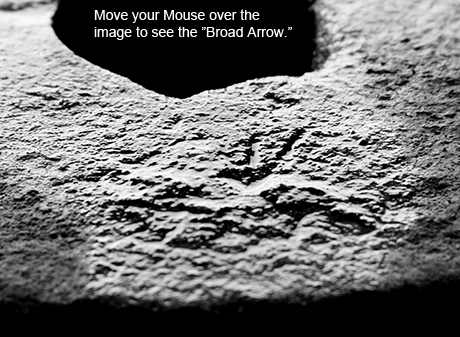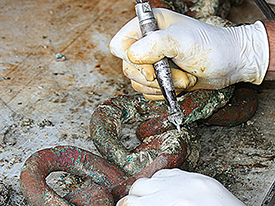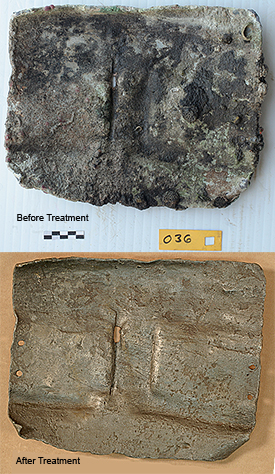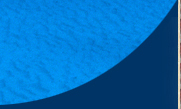
Conservation
31 January 2012
By Chris Cartellone
When the diving ends, the real work begins. As a professional archaeologist, it is my responsibility to share the results. Thus far I have presented the project at university talks and most recently the Society for Historical Archaeology's annual conference in Baltimore, Maryland. The presentations, exhibits, and publications are the products of our efforts to produce and share knowledge about the past. I acknowledge that ownership of the results belongs to everyone, the artifacts will be entrusted to the people of Nevis, through the stewardship of the Nevis Historical and Conservation Society. Ultimate ownership of the shipwreck belongs to the British Royal Navy and their right to sovereign immunity under international law.

Artifact in process of conservation reveals a "Broad Arrow," the distinctive mark identifying British government property.(Photograph by Brennan Bajdek.)
The fieldwork is the visibly exciting phase of archaeology, but the weeks, months, and sometimes years of post-fieldwork research and analysis of data and artifacts is where professional archaeologists earn their pay. Through this process, the results are shared via publications in books and journal articles, and through professional and public presentations. While seemingly tedious, this research phase can be more exciting than the fieldwork and may be characterized as the excavation of data, as artifacts begin to reveal clues to the past. But first, the artifacts must be conserved.

Brennan Bajdek examining and cleaning lead artifact. (Photograph by Jessica Stika.)
The artifacts from Project Solebay have been undergoing treatment at Texas A&M University's Conservation Research Laboratory. This can be a long process as artifacts are cleaned. This requires a conservator to apply a combination of mechanical, chemical, and electrical processes. Conservators choose treatments based on material compositions and state of degradation. While there are proven and prescribed methods, these approaches must be guided by experience that allows for small adjustments to each particular artifact and its discovered environmental conditions.

Chris Cartellone air scribing copper chain. (Photograph by Brennan Bajdek.)
Generally, all artifacts followed similar treatment plans for this project. Since all materials were either plumbic or cupreous, this made it easier to process in batches. The first step requires conservators to photograph and measure each artifact, and record their observations on artifact cards. Sometimes the finest conservators and treatment plans cannot save the most fragile artifacts despite their best efforts. In these instances, the pre-conservation images and observations may be the last source of data before the artifact is lost forever.

Brennan Bajdek observing chain in electrolytic reduction vat. (Photograph by Chris Cartellone.)
Since the artifacts came from the ocean, and had been resting on the seafloor for 230 years, they must be kept submerged in water until conserved. They may be removed for short periods to examine or clean, but if left exposed for extended days or months to dry they will become destroyed from microscopic sea salts crystallizing and fracturing the fragile metals. This unfortunate process can often be seen in artifacts throughout the world that have been removed by untrained divers that pull cannons up on a beach, for example. After a few years they start to split and crack until the entire cannon breaks into pieces.
All materials had some degree of encrustation of calcium carbonate. Each artifact was examined and mechanically cleaned using any instruments necessary. Typically, dental tools and soft toothbrushes work well to scrape the exterior, careful not to scratch or damage the artifact's surface. For more extensive and larger needs, a small pneumatic air scribe works like a miniature jackhammer to quickly detach, chisel, and cleave encrustations.

Lead artifact before and after conservation. Large View (Photographs by Chris Cartellone & Jessica Stika.)
Once the conservator has removed as much material as possible without risk to damaging the artifact, a combination of chemical and electrical treatments begins. A hydrochloric acid solution removes excess material left after the mechanical cleaning. For the lead, a chemical and water boiling solution followed by a microcrystalline wax treatment serves to clean and then seal the artifact to prevent future corrosion.
The copper artifacts followed a similar plan, but after initial cleanings are subjected to months of electrolytic reduction. This method places the artifact in a submerged vat containing water and a chemical electrolyte. The artifact is then connected to wires that transmit a low voltage, low amperage electrical current over a period of months. This process removes remaining salts. Conservators test the solution surrounding the artifact on a weekly basis and record their observations. Over time, the conservator monitors the decreasing levels of salt. Once satisfied that the salt levels have neutralized, the artifact may be removed, boiled, and sealed similar to the lead.
The artifacts may finally be safely left out of water to be studied, placed in storage, or exhibited in a museum. Currently, the lead artifacts from Solebay have completed conservation. Many of the cupreous artifacts are almost done, but require more time due to the slow nature of the electrolytic reduction process. When finished, these materials will be carefully studied, and then returned to Nevis for display in a museum exhibit.
For now, our team will patiently observe the conservation and await the final results. Once finished, the next immediate steps are to study the artifacts, and prepare them for delivery and exhibit in Nevis. Please check back in a few months as I expect to discuss the results. To learn more about the science of conservation, please visit the website: http://nautarch.tamu.edu/CRL/conservationmanual/. As always, if you have any questions or comments, please contact me through my university email: cartellone@tamu.edu.
Return to MUA Project Journals home page.

